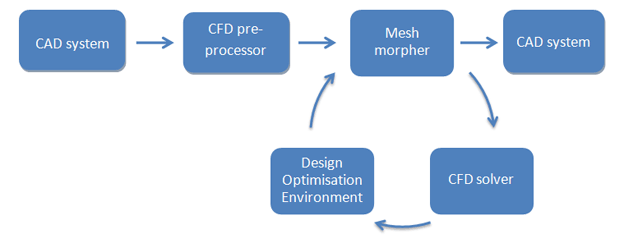DESIGN SHAPE OPTIMIZATION AND MESH MORPHING
With the increasing accuracy of modern Computational Fluid Dynamics (CFD) systems, both in the compressible and incompressible fluid domains, engineers are now able to assess the performance of a specific design through virtual prototyping.
This is substantially reducing costly experimental tests such as those carried out in wind tunnels to a minimum.
In principle, engineers can now explore the performance of several designs to determine the optimal shape of a component. Design optimization can take into account multiple conflicting objectives and complex constraints. The optimization process can be automated by using a multi-objective optimization design environment which saves time and money thanks to a faster, more accurate and efficient exploration of the design space.
Traditional CAD-in-the-loop Approach to Design Shape Optimization
In a traditional CAD-in-loop approach to design shape optimization:
- CAD parameters are changed
- the CAD model is regenerated
- the new design is exported to the CFD system pre-processor
- the new mesh is then generated
- the CFD analysis is run and the new results are calculated
Unfortunately this traditional "CAD-in-the-loop" approach is complex and difficult to automate. Parameterizing the CAD model is often difficult, CAD-system dependent and embeds additional and, often, unwanted constraints into the model. Regeneration of complex CAD models may fail under some combination of parameters.
The CAD model may require manual rework before a suitable mesh with the required quality can be obtained. As the topology of the CAD model and of the mesh may change with the shape, the CFD model may need to be reprocessed in order to reapply the boundary conditions before an analysis can be launched.
Mastering Design Shape Optimization using Mesh Morphers

Mesh morphers solve the issues faced when using a traditional CAD-in-the-loop approach.
In the “mesh-morpher-in-the-loop” shape optimization approach depicted in the diagram below, the original CAD shape is imported only once into the CFD system pre-processor, the mesh is generated and imported into to the mesh morpher tool.
The mesh is then parameterized and deformation vectors, based on design constraints and realistic assumptions, are added to the model.
Mesh quality controls are set in order to guarantee the quality of the CFD simulation results. The mesh morpher modifies the mesh respecting the original topology, therefore allowing the reliable use of a design optimization environment to automate the loop, for example by using evolutionary algorithms.
When using a mesh morpher a parametric CAD system is not required, and a direct modeling CAD system may be used instead. Once the optimal model has been obtained and assessed, “back-to-CAD” functionalities are available to generate the modified CAD model, needed for carry over, additional simulations, rapid prototyping, tooling, etc.
Mesh morphers allow for faster and more robust design shape optimization for CFD analysis. Optimization time and costs can be slashed by a factor of 10, enabling a more detailed exploration of the design space, accelerating the design phase and shortening the time-to-market. Furthermore, by avoiding unneeded parameterization constraints, original, unexpected new designs are often obtained.

